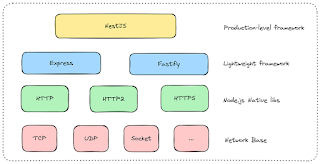Why You Shouldn’t Use NestJS
Why You Shouldn’t Use NestJS: Weighing the Downsides
NestJS has gained popularity as a progressive Node.js framework for building scalable and maintainable server-side applications. It leverages TypeScript, follows a modular architecture, and integrates well with popular technologies. However, despite its many advantages, NestJS may not be the best choice for every project. In this blog, we’ll explore some key reasons why you might want to reconsider using NestJS.
1. Steep Learning Curve
NestJS introduces a lot of concepts such as dependency injection, decorators, modules, and providers, which can be overwhelming for developers coming from a traditional JavaScript or Express.js background. If your team is not familiar with Angular-style architecture, the learning curve can slow down development.
2. Overhead & Complexity
For small projects, NestJS can introduce unnecessary complexity. The framework enforces a structured approach, which may feel like overkill when building simple APIs. The extensive boilerplate code required for controllers, services, and modules may result in a bloated codebase compared to lightweight alternatives like Express.js.
3. Performance Overhead
While NestJS provides excellent scalability and maintainability, it does come with some performance overhead. Due to its heavy reliance on TypeScript, metadata reflection, and additional layers of abstraction, it might not be as fast as minimalistic Node.js frameworks like Fastify or Express.
4. Opinionated Framework
NestJS follows a strict architectural pattern inspired by Angular. While this structure benefits large-scale applications, it limits flexibility for developers who prefer a more lightweight, unopinionated approach. If you enjoy having full control over your project’s structure, NestJS may feel restrictive.
5. Limited Community & Ecosystem
Although NestJS has an active and growing community, it is still relatively smaller compared to more established frameworks like Express or Fastify. Finding solutions to unique problems may take longer, and some third-party libraries may not have full NestJS compatibility.
6. Dependency on TypeScript
NestJS is built with TypeScript by default, which may be a drawback for teams that prefer JavaScript. While TypeScript brings type safety and maintainability benefits, it can also increase development complexity, especially for those unfamiliar with it.
When Should You Still Use NestJS?
Despite these downsides, NestJS is an excellent choice for enterprise applications, large-scale APIs, and projects requiring maintainability, scalability, and modularity. If your team is comfortable with TypeScript and Angular-style architecture, NestJS can be a great asset.
Conclusion
While NestJS offers a lot of powerful features, it is not a one-size-fits-all solution. Its learning curve, complexity, and performance trade-offs may make it less suitable for small projects or teams looking for a lightweight and flexible framework. Before choosing NestJS, consider your project’s specific needs and whether a simpler alternative might be a better fit.
What are your thoughts on NestJS? Have you faced any challenges using it? Share your experiences in the comments below!





Comments
Post a Comment